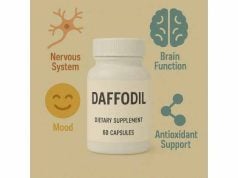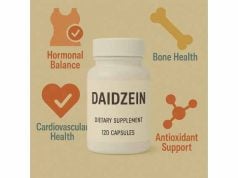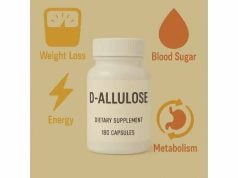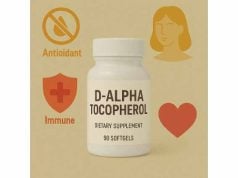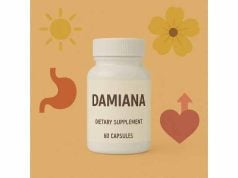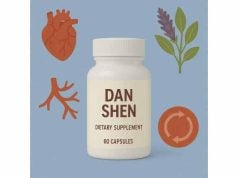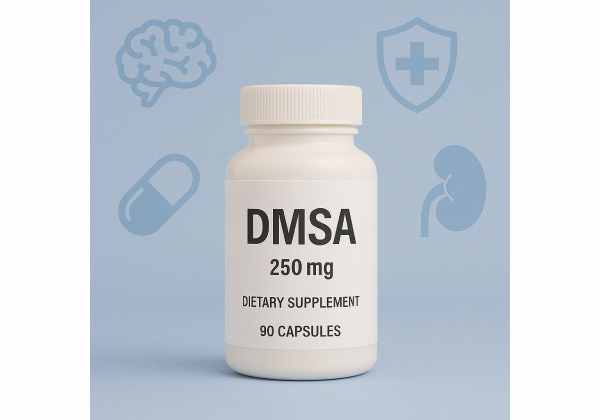
DMSA—also known by its generic name succimer—is a prescription chelating agent designed to bind certain toxic metals so your body can excrete them. Clinically, it is used mainly for lead poisoning in children and, in select circumstances, for arsenic or inorganic mercury exposure under specialist care. Compared with older chelators, DMSA is taken orally and is generally better tolerated. Still, it’s not a wellness detox and it carries real risks without a documented benefit when used outside medical indications. This guide explains how DMSA works, when it’s appropriate, how it’s dosed and monitored, what to expect during treatment, who should avoid it, and what the strongest evidence actually shows—so you can discuss options with a qualified clinician using the same playbook they do.
Essential Insights for DMSA Users
- Lowers blood lead levels; limited, specialist use for arsenic or inorganic mercury.
- Typical course: 10 mg/kg every 8 hours for 5 days, then every 12 hours for 14 days (oral).
- Monitor CBC and liver enzymes; watch for rash and neutropenia.
- Not for routine “detox” or provoked urine testing; medical evaluation first.
- Avoid if pregnant unless benefits clearly outweigh risks; seek expert toxicology input.
Table of Contents
- What is DMSA and how does it work?
- When should DMSA be used?
- How to take DMSA: dosing and monitoring
- What to expect during treatment
- Who should not use DMSA and key risks
- What the evidence says and what it does not
What is DMSA and how does it work?
DMSA (succimer) is a dithiol chelator—an organic molecule with two sulfhydryl (–SH) groups positioned to grab onto “soft” metal ions such as lead (Pb²⁺) and, to a lesser extent, mercury and arsenic in certain forms. When DMSA binds a target metal, it forms a water-soluble complex that the kidneys can excrete in urine. This is the therapeutic goal: convert a toxic, tissue-bound metal into a complex that leaves the body safely.
DMSA’s structure helps explain both its usefulness and its limitations. Because DMSA is hydrophilic (water-loving) and largely remains in the extracellular space, it has modest penetration into the central nervous system. In practice, that means DMSA effectively lowers blood lead levels and body burden, but it does not reverse established neurotoxicity, nor does it treat lead encephalopathy on its own. In severe encephalopathy, intravenous agents and inpatient care are needed.
Compared with older chelators like dimercaprol (BAL) or edetate calcium disodium (CaNa₂EDTA), DMSA’s key advantages are oral dosing, a generally favorable safety profile, and less disruption of essential minerals such as calcium and magnesium. Zinc excretion can increase temporarily during treatment; clinicians account for that in monitoring plans. Another practical edge: DMSA has a half-life around two days for total radiolabeled material in blood, and peak plasma levels occur 1–2 hours after an oral dose—timing that informs real-world dosing schedules and follow-up labs.
In clinical toxicology, DMSA occupies a specific niche rather than a catch-all role. It is FDA-labeled in the United States for pediatric lead poisoning above defined thresholds, and it is prescription-only. For arsenic or inorganic mercury exposure, DMSA may be used off-label by specialists after confirming the exposure type and timing; organic mercury exposures (e.g., from certain seafood) behave differently and may not respond the same way.
Finally, it’s important to separate evidence-based chelation from non-medical “detox” claims. DMSA is not a wellness tonic; it is a drug with clear indications, measurable targets, and known risks. If testing and exposure history don’t support chelation, the best “treatment” is eliminating the source and supporting the body—not taking a chelator “just in case.”
When should DMSA be used?
The core, evidence-based indication for DMSA is pediatric lead poisoning when venous blood lead levels (BLLs) reach or exceed 45 μg/dL, or when a child with moderately elevated BLLs has persistent elevation despite environmental interventions and a clinician judges chelation appropriate. Public health guidance evolves; as of 2025, the CDC’s Blood Lead Reference Value is 3.5 μg/dL for identifying children with BLLs higher than most peers, but chelation is reserved for substantially higher levels and/or significant symptoms. In other words, most children with detectable lead do not need chelation; they need exposure removal, nutritional support (iron and calcium), and serial monitoring under pediatric guidance.
In the hospital or specialist setting, DMSA may be chosen when:
- A child has a confirmed venous BLL ≥45 μg/dL without signs of encephalopathy.
- A child with BLL 20–44 μg/dL has persistent elevation despite robust environmental remediation and clinical judgment supports chelation.
- There is confirmed arsenic or inorganic mercury exposure where a dithiol chelator is appropriate, and the case is managed by a medical toxicologist. Timing matters: acute exposures benefit most when chelators are started promptly after exposure ends; chronic, low-level exposures are handled by removing the source and careful follow-up rather than reflex chelation.
Not appropriate uses include:
- Routine “detox” in people without documented, clinically significant heavy metal exposure.
- Treatment based solely on “provoked” or “post-challenge” urine tests, which artificially boost urinary metals after giving a chelator. These tests do not diagnose poisoning and can lead to needless—and risky—chelation.
- Lead encephalopathy (severe neurologic toxicity), which requires urgent inpatient care often with different agents and intensive monitoring; DMSA does not cross the blood–brain barrier sufficiently to treat encephalopathy.
For adults, DMSA is often used off-label by clinical toxicologists when indicated by the exposure (e.g., occupational lead or acute inorganic mercury). The decision weighs exposure history, current and prior BLLs or urine levels (for the relevant metal), symptoms, and the feasibility of eliminating the source. Because chelation transiently lowers circulating metal while reservoirs (like bone) re-equilibrate, clinicians plan follow-up testing and may repeat courses if rebound occurs after exposure control is secured.
A final note on context. DMSA therapy is never a stand-alone fix. Treatment plans always include:
- Source control (home abatement, workplace protections, diet, and water remediation).
- Nutritional strategy (adequate iron and calcium).
- Developmental surveillance in children (regardless of chelation), since reducing BLL does not guarantee neurocognitive gains.
How to take DMSA: dosing and monitoring
Standard pediatric regimen (lead):
A commonly used course is 10 mg/kg by mouth every 8 hours for 5 days, followed by 10 mg/kg every 12 hours for 14 days (total 19 days). Dosing is weight-based; clinicians round doses to practical capsule counts and adjust for tolerability and lab results. Adequate hydration is recommended throughout therapy.
Administration tips:
- Swallow capsules whole when possible. For young children who cannot, clinicians may instruct caregivers to open the capsule and sprinkle the beads on a small amount of soft food, followed by a fruit drink. This preserves dosing accuracy while making administration more feasible.
- Take at consistent intervals to maintain steady chelator levels.
- Do not double doses if one is missed; call your clinician for instructions.
Monitoring plan:
A safe chelation plan tracks therapeutic response and early warning signs:
- Baseline labs: venous BLL (or the relevant test for arsenic/mercury), complete blood count (CBC) with differential, and liver enzymes (ALT/AST). Consider renal function evaluation, especially if there’s a history of kidney disease.
- During therapy:
- CBC weekly to detect neutropenia (an abnormal drop in neutrophils). If absolute neutrophil count (ANC) falls below a cutoff (often <1,200/μL), DMSA is held and the care team evaluates for infection and alternative causes.
- Liver enzymes periodically; if >5× the upper limit of normal or if symptoms suggest liver injury, therapy is interrupted and reassessed.
- Hydration status and gastrointestinal tolerability (nausea, vomiting, appetite, bowel changes).
- After therapy:
- Rebound check: BLLs often rise again after chelation ends because metals move from deep stores back into blood. A scheduled follow-up BLL helps determine whether a second course is warranted and, crucially, whether the source has truly been eliminated.
- Intervals between courses allow bone and tissue stores to re-equilibrate and limit cumulative toxicity; clinicians individualize timing based on labs and exposure control.
Repeat courses:
If BLL rebounds and exposure control is verified, clinicians may repeat a DMSA course after a gap (often ≥2 weeks from the last dose). Each repeat requires the same safety checks (CBC, liver enzymes, symptom review).
Drug and nutrient considerations:
- DMSA can increase urinary zinc loss transiently; clinicians may advise zinc-adequate diets and avoid unnecessary supplements during the chelation course unless indicated.
- Because chelators can interfere with some lab assays, always tell the laboratory and your clinician you’re on DMSA when tests are ordered during treatment.
- Avoid starting new, nonessential supplements or medications without checking for interactions or confounding effects on monitoring.
Setting and oversight:
Chelation should be prescribed and followed by clinicians with toxicology experience or in consultation with a Poison Control Center or a Pediatric Environmental Health Specialty Unit (PEHSU). They tailor dosing, frequency of labs, and the total number of courses to your case.
What to expect during treatment
Most patients tolerate DMSA, but minor side effects are common, especially early on. Expect the care team to set clear guardrails: what’s expected, what’s a red flag, and when to call.
Common, usually self-limited effects
- Gastrointestinal: nausea, vomiting, diarrhea, decreased appetite, or a metallic taste. Taking doses with a small snack can help if your clinician approves.
- General: fatigue or headache in some patients.
- Urine changes: because chelation increases urinary metal excretion, clinicians emphasize hydration to support the kidneys.
Less common but important
- Skin reactions: mild rashes can occur; more serious mucocutaneous eruptions are rare but require immediate attention and drug discontinuation.
- Neutropenia: a drop in white blood cells (ANC). You won’t “feel” a lab change, which is why scheduled CBCs are essential. Fever, sore throat, or other signs of infection during therapy demand urgent contact with your team.
- Liver enzyme elevations: usually asymptomatic and reversible with drug interruption.
Course dynamics
- Speed of BLL reduction: You’ll typically see a prompt fall in blood lead during the first week, reflecting increased urinary excretion. This does not guarantee symptom reversal, particularly for cognitive or behavioral effects in children.
- Rebound phenomenon: After the course ends, BLL often rises part-way back as metal redistributes from deeper stores. This is expected; your clinician plans follow-up labs to decide on next steps.
- Total duration: Many children complete one 19-day course; some need another after reassessment, always in parallel with source removal (home abatement, water line fixes, workplace changes).
What caregivers can do
- Keep a dosing log (time, dose given, any symptoms).
- Prevent re-exposure: wet-mop floors, wipe windowsills, use certified contractors for any renovation in pre-1978 housing, and review workplace hygiene (“take-home” lead from jobs).
- Prioritize dietary iron and calcium within a balanced diet to reduce gastrointestinal lead absorption.
What not to do
- Do not take additional chelators or over-the-counter “detox” products alongside DMSA; these may interact, dehydrate you, or confound lab tests without benefit.
- Do not rely on home test kits or provoked urine tests to decide on therapy; decisions should rest on validated clinical testing and specialist input.
Communication plan
Before starting, clarify who to call for: rash, fever ≥38°C, persistent vomiting, new jaundice, or any missed doses. Ask how the team will share lab results and what thresholds trigger changes. Knowing this upfront reduces anxiety and keeps treatment safe.
Who should not use DMSA and key risks
Absolute contraindication
- History of hypersensitivity to succimer (DMSA). Reactions can range from rash to angioedema and mucocutaneous eruptions. If any sign of an allergic reaction occurs, stop the drug and seek immediate care.
Use only with caution and specialist oversight
- Pregnancy: DMSA carries potential embryo-fetal risk and is used only if benefits clearly outweigh risks. Lead itself poses pregnancy risks (e.g., hypertension, adverse fetal outcomes), so management is individualized with obstetrics and toxicology input.
- Breastfeeding: Guidance may recommend temporary interruption of breastfeeding at very high maternal BLLs; clinicians focus on lowering maternal BLL and ensuring infant safety before resuming.
- Liver disease: Because DMSA can raise ALT/AST, baseline and periodic monitoring are essential; severe elevations warrant stopping therapy.
- Renal impairment: Ensure adequate hydration and closer monitoring; chelator complexes may not be effectively dialyzed once formed, and renal stress should be avoided.
- Infants under 1 year: Safety and effectiveness are not established; such cases require specialist consultation.
Key risks to understand
- Neutropenia: Though infrequent, it is clinically significant. Your care team will order weekly CBCs and will hold DMSA if ANC falls below threshold (often <1,200/μL), restarting only after recovery and if benefits outweigh risks.
- Dermatologic reactions: Rash (~a few percent) is the most common; more severe lesions are rare but mandate discontinuation.
- Hepatotoxicity: Transaminase elevations occur in a subset; most resolve with drug interruption.
- Nutrient shifts: Zinc excretion may increase; however, routine mineral supplementation is not automatic and should be clinician-directed to avoid interactions.
- False reassurance or misdirection: Chelation can lower blood metal levels without addressing the source, leading to rebound and ongoing harm. Successful care always prioritizes exposure elimination.
Practices to avoid
- Provoked urine testing (collecting urine after a chelator dose to “unmask” hidden metals) is not validated and can lead to misdiagnosis and unnecessary chelation. Stick to standardized testing interpreted by clinicians who understand assay limitations.
- Non-medical indications (autism, fatigue, “brain fog,” anti-aging) lack evidence and can be dangerous, especially with unregulated products.
If you’re unsure whether DMSA is right for your situation, consult a medical toxicologist or Poison Control (in the U.S., 1-800-222-1222). They can help interpret results, weigh risks and benefits, and design a safe plan that starts with removing exposure.
What the evidence says and what it does not
Leads the field for pediatric lead detoxification (in the right cases). Randomized trials and clinical experience show DMSA reliably lowers BLLs in young children with moderate lead exposure over the standard 19-day course. That pharmacologic effect is reproducible and clinically useful—particularly when paired with environmental interventions to prevent rebound.
But biochemical success ≠ neurodevelopmental cure. A landmark randomized, placebo-controlled trial in children with BLLs 20–44 μg/dL found that DMSA lowered blood lead during active therapy but did not improve IQ or most neuropsychological outcomes at follow-up. This finding shapes modern guidance: below the thresholds for severe poisoning, primary prevention and exposure elimination are the key drivers of long-term outcomes, not chelation alone.
For arsenic and inorganic mercury: High-quality randomized data are limited; evidence comes from toxicology mechanisms, animal studies, case experience, and expert consensus. Dithiol chelators (DMSA, DMPS) enhance urinary excretion of these metals and are often used under specialist direction in acute, significant exposures. Choice of agent, timing, and duration are tailored to the compound (e.g., inorganic vs organic mercury), the route and timing of exposure, and the patient’s clinical status.
Safety profile in context: Compared with older agents (BAL, CaNa₂EDTA), DMSA offers oral dosing and generally fewer severe adverse effects, but the risks—neutropenia, hepatotoxicity, and hypersensitivity—are real. This is why monitoring is baked into every protocol and why home “detox” programs without proper testing and follow-up are unsafe.
Why “provoked” testing is discouraged: Giving a chelator and then measuring urine metals will raise urinary concentrations—even in healthy individuals—because chelators mobilize metals. Those values don’t diagnose poisoning, don’t correlate with illness severity, and often mislead patients into unnecessary treatment. Professional toxicology organizations advise against using these tests to determine chelation candidacy.
Bottom line for decision-making:
- Children with BLL ≥45 μg/dL: DMSA chelation is often appropriate, alongside urgent source control and pediatric environmental health support.
- Milder elevations: Focus on exposure removal, nutrition, and surveillance; chelation usually not indicated, and it won’t restore neurodevelopmental milestones on its own.
- Arsenic/inorganic mercury: Consider specialist-guided chelation in acute poisoning with confirmed exposure, after eliminating the source.
- No confirmed exposure or non-evidence indications: Avoid chelation; risks outweigh benefits.
If you take one message from the evidence, let it be this: DMSA is a useful tool in a narrow, well-defined clinical context—not a general detox. The best outcomes come from early detection, removing the exposure, and targeted chelation when the criteria are truly met.
References
- Label: CHEMET- succimer capsule – DailyMed 2025 (Guideline/Label)
- Recommended Actions Based on Blood Lead Level | Childhood Lead Poisoning Prevention | CDC 2025 (Guideline)
- Guideline for clinical management of exposure to lead 2021 (Guideline)
- The effect of chelation therapy with succimer on neuropsychological development in children exposed to lead – PubMed 2001 (RCT)
- The Role of Chelation in the Treatment of Arsenic and Mercury Poisoning – PMC 2013 (Systematic Review/Review)
Medical Disclaimer
This article provides general information about DMSA (succimer) and does not replace personalized medical advice. Chelation therapy carries risks and should only be started after appropriate evaluation, confirmatory testing, and clinician oversight. If you suspect a heavy metal exposure, seek immediate guidance from your healthcare professional, a medical toxicologist, or your local Poison Control Center. Never start, stop, or change any medication based on online information alone.
If you found this guide helpful, please consider sharing it on Facebook, X (formerly Twitter), or any platform you prefer, and follow our social channels. Your support helps us continue creating high-quality, evidence-based resources.

